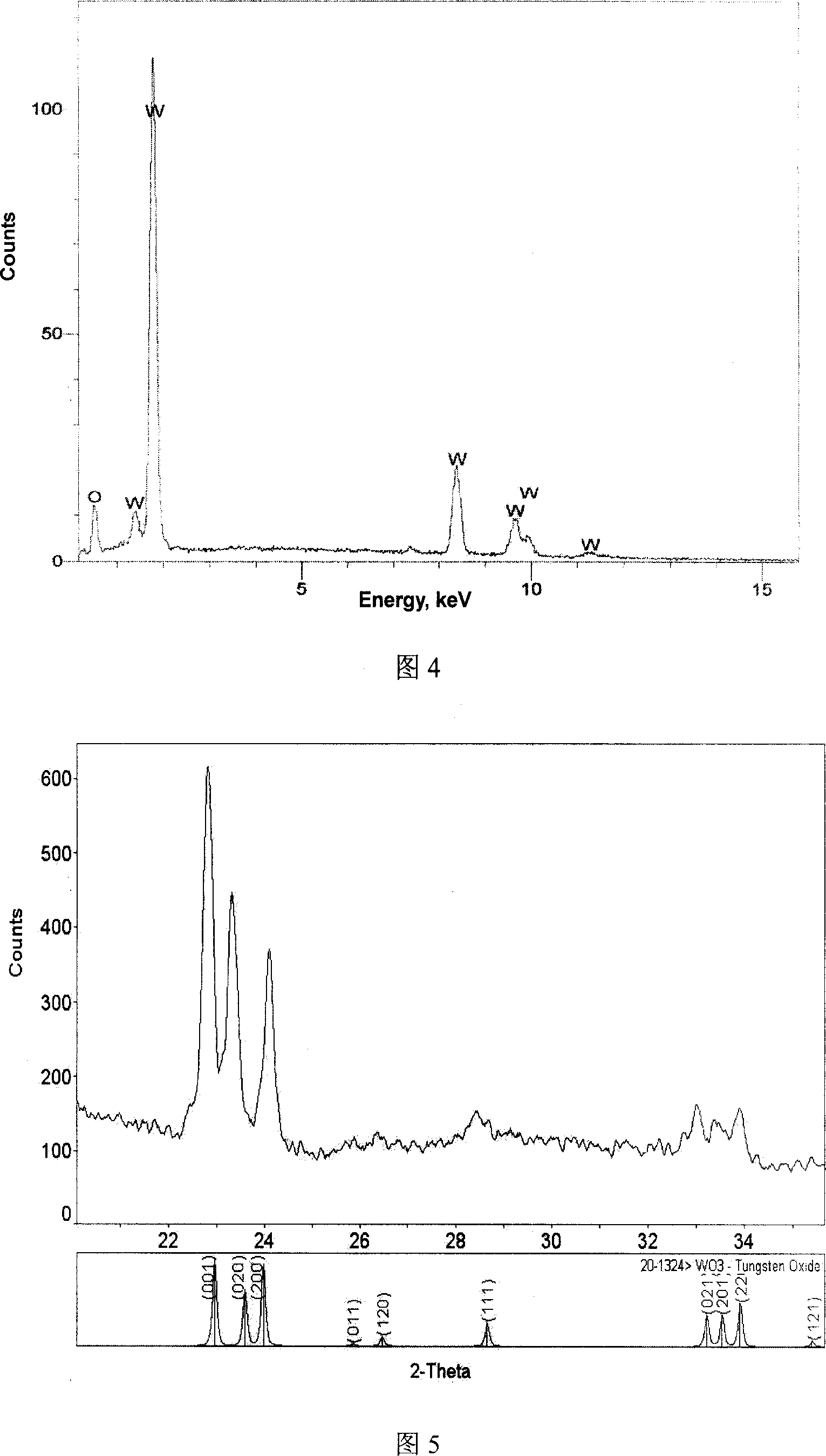Tungsten oxide material with nano band array structure and its preparing method
An array structure and tungsten oxide technology, applied in the field of nanomaterials, can solve the problems of cumbersome processing process, limited specific surface area of tungsten oxide nanorods, weak combination of tungsten oxide and matrix, etc., and achieve the effect of simple preparation process
- Summary
- Abstract
- Description
- Claims
- Application Information
AI Technical Summary
Problems solved by technology
Method used
Image
Examples
Embodiment 1
[0033] The preparation steps of the tungsten oxide nanobelt array structure with a diameter of 1mm metal straight tungsten wire as the reaction matrix are as follows:
[0034]The first step is to fix the metal tungsten wire at both ends of the positive and negative terminals of the heating power supply, and seal the reaction chamber;
[0035] In the second step, the pressure of the reaction system was evacuated to 4000 Pa with a rotary vane vacuum pump, and then the vacuum pump was turned off. Turn on the heating power, slowly increase the heating current, control the substrate temperature at 500°C, keep the heating current stable, and react for 30 minutes;
[0036] The third step is to turn off the heating power supply, keep the vacuum degree of the reaction chamber unchanged, and after cooling to room temperature naturally, open the reaction chamber to take out the sample;
[0037] The fourth step is to carry out material analysis with scanning electron microscope, transmis...
Embodiment 2
[0040] The preparation steps of the tungsten oxide nanoribbon array structure using a metal tungsten sheet with a length of 8 cm, a width of 5 mm, and a thickness of 0.25 mm as a reaction substrate are as follows:
[0041] The first step is to fix the metal tungsten sheet at both ends of the positive and negative terminals of the heating power supply, and seal the reaction chamber;
[0042] In the second step, the pressure of the reaction system was pumped to 5000 Pa with a rotary vane vacuum pump, and then the vacuum pump was turned off. Turn on the heating power, slowly increase the heating current, control the substrate temperature at 800°C, keep the heating current stable, and react for 15 minutes;
[0043] The 3rd step is with the 3rd step of embodiment 1;
[0044] The 4th step is the same as the 4th step of embodiment 1.
[0045] The test results show that the tungsten oxide material with nanoribbon array structure growing perpendicular to the substrate direction can b...
Embodiment 3
[0047] The preparation steps of the tungsten oxide nanoribbon array structure with three 0.3mm diameter helically wound metal tungsten wires as the reaction matrix are as follows:
[0048] The first step is to fix the spiral metal tungsten wire at both ends of the positive and negative terminals of the heating power supply, and seal the reaction chamber;
[0049] In the second step, the pressure of the reaction system was pumped to 3000 Pa with a rotary vane vacuum pump, and then the vacuum pump was turned off. Turn on the heating power supply, slowly increase the heating current, control the substrate temperature at 1100°C, keep the heating current stable, and react for 5 minutes;
[0050] The 3rd step is with the 3rd step of embodiment 1;
[0051] The 4th step is the same as the 4th step of embodiment 1.
[0052] The test results show that the tungsten oxide material with nanoribbon array structure growing perpendicular to the direction of the substrate can be obtained. Th...
PUM
| Property | Measurement | Unit |
|---|---|---|
| length | aaaaa | aaaaa |
| width | aaaaa | aaaaa |
| thickness | aaaaa | aaaaa |
Abstract
Description
Claims
Application Information
 Login to View More
Login to View More - R&D
- Intellectual Property
- Life Sciences
- Materials
- Tech Scout
- Unparalleled Data Quality
- Higher Quality Content
- 60% Fewer Hallucinations
Browse by: Latest US Patents, China's latest patents, Technical Efficacy Thesaurus, Application Domain, Technology Topic, Popular Technical Reports.
© 2025 PatSnap. All rights reserved.Legal|Privacy policy|Modern Slavery Act Transparency Statement|Sitemap|About US| Contact US: help@patsnap.com


